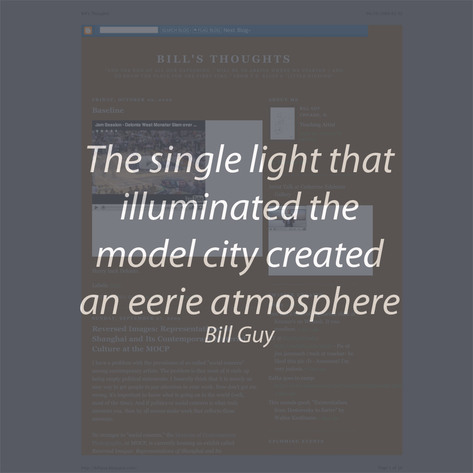billsthoughts.com : Reversed Images
Publication Title: billguy.blogspot.com/Writer: Bill Guy
Publication Date: 2nd October 2009
I have a problem with the prevalence of so-called "social concern" among contemporary artists. The problem is that most of it ends up being empty political statements. I honestly think that it is merely an easy way to get people to pay attention to your work. Now don't get me wrong, it's important to know what is going on in the world (well, most of the time). And if politics or social concern is what truly interests you, then by all means make work that reflects those interests.
No stranger to "social concern," the Museum of Contemporary Photography, or MOCP, is currently housing an exhibit called Reversed Images: Representations of Shanghai and Its Contemporary Material Culture. Everyone tells me what [sic] China is growing at an alarming rate, is on the verge of being a world super power, and that we should know all about it. So I went to check out what the MOCP had to offer, gritting my teeth on the way there, of course. I was, however, pleasantly surprised. I encountered a range of artistic approaches, including photography, video, sculpture, and installation. And along with that I encountered a range of ideas, including history, sociology, and urban planning. Some work was academic, others were playful, and most of the work succeeded in adding a wrinkle to my understanding of Chinese society and culture. These three works were my favorites:
In the museum's first-floor east gallery is a sculpture by David Cotterrell titled South Facing:
[image omitted]
The title is derived from the Chinese dictate that "each new building be at least 15 degrees south-facing, reflecting the emperor’s palaces in which private quarters faced south and the less valued courtiers’ rooms faced east or west." As a red-blooded American champion of democracy, the uniformity of the all white buildings made me think of the restrictions of a communist society (I think that might be sarcasm?). The small scale made the rows of small building situated on the gallery floor seem quite fragile. The only thing preventing me from stomping on them was a thin white cord. The single light that illuminated the model city created an eerie atmosphere, or "the aura of a silent funerary monument" as described by the curatorial statement. If I were to design this sculpture, I would of [sic] added tiny little people on the ground in-between the rows of buildings. But that's my bias, of course.
In that same room is a sculpture by Su Chang titled “Citylife really makes your life better?”
[Image omitted]
This sculpture is a replica of the older homes that are being torn down in Shanghai to make room for new development. How does the artist feel about this transition? That is for the viewer to decide. But seeing the home isolated on a museum pedestal gave me an uneasy feeling. As I looked closer, I noticed that the skin of the building was torn back, revealing the bare plumbing underneath. Progress can be good, but this replica of a deteriorating building could act as a metaphor for the general entropy of contemporary Chinese culture. Far to often a sense of history and culture is lost all in the name of progress. It's interesting to think about this model home in juxtaposition to the pristine white buildings of the Cotterrell work. In the Cotterrell work, which represents the present, the buildings are all pristine and white, though uniform. In Su Chang's sculpture, the building is crumbling, but it is an individual.
Zhang Qing's work uses a series of video monitors along with a number of still photographs from the video: In both the video and stills, a group of Chinese youth play soccer in a small Shanghai apartment. As a Chicago-transplant, I understand the yearning for space and freedom that the curatorial statement points out. Having grown-up with a big back yard, farm land just down the street, and natural woods a short bike ride away, urban life is suffocating to me, to say the least.
The way that space is restricted is Kafkaesque. In Kafka's work, space is often quite restricted, leaving the central character feeling anxious and trapped. This is evident in his novel “Amerika” when Karl Rossmann visits the stoker in his small room. As well, in his novel “The Trial” when Josef K. visits the courts, only to pass out from the stale air of that very court house.
In Zhang Qing video, however, the youths seem positive in their soccer playing and in their ability to make the best of their situation. Sitting back and watching the soccer game transpire across the different monitors is actually quite funny, but it does so without making fun of the subjects. And that is a fundamental difference between the works in this exhibit, and so much of the rest of the contemporary art world.
Bill Guy
Download this file here, or click the image on the right.Share:
Twitter / Facebook / Pinterest
